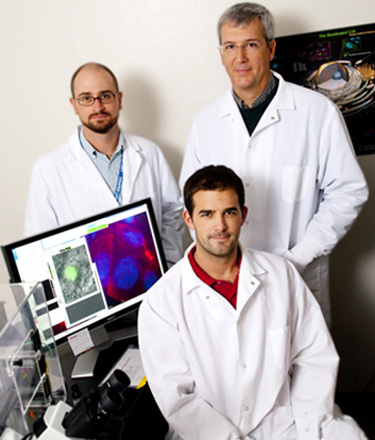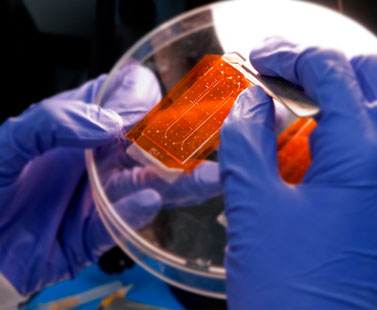USF and Draper collaborate to create advanced devices for testing malaria drugs
Gates Foundation awards two grants totaling $5.45 M for cutting-edge laboratory research
Tampa, FL (Feb. 8, 2011) — The University of South Florida received $5.45 million in grants from the Bill & Melinda Gates Foundation. The first grant is to create advanced devices that mimic the human liver to better study the life cycle of the malaria parasite – particularly the elusive liver stage where the disease may be most vulnerable to attack. Such human models could help accelerate the discovery of new drugs or even vaccines for Plasmodium vivax and Plasmodium falciparum, the two most common forms of malaria becoming increasingly resistant to today’s therapies. The second grant is to provide effective therapeutics to prevent and cure malaria by developing long-term continuous culture system for P. vivax
USF will collaborate with Draper Laboratory on the projects. The dynamic public-private partnership combines the USF Global Infectious Disease Research team’s expertise in malaria parasite biology and human model development with Draper’s extensive experience in tissue engineering and the development of human mimetic in vitro (laboratory) models.
“We cannot eliminate one of the most prevalent causes of malaria in the world – Plasmodium vivax – unless we come up with new drugs or vaccines that target the dormant liver forms of the parasite,” said Dennis Kyle, Ph.D., professor of global health at the USF College of Public Health. “Current tools– in vitro and animal models are either largely ineffective or cost-prohibitive in predicting which drugs may work best in humans. New human models are the basic building blocks needed to establish strong, credible drug and vaccine discovery programs, not only at USF but at other universities and companies working on new ways to fight malaria.”

Clockwise from left: Principal investigators Dr. John Adams and Dr. Dennis Kyle of USF Health, are collaborating with Dr. Joseph Cuiffi of Draper Laboratory.
Dr. Kyle is the principal investigator for a three-year Gates Foundation grant seeking to develop human liver models that could more quickly and accurately test potential drug candidates for vivax and falciparum malaria. Draper Laboratory’s efforts will be overseen by principal investigator Joseph Cuiffi, PhD, of the Draper Bioengineering Center at USF. They are working with John Adams, Ph.D., professor of global health at USF; Jeffrey Borenstein, Ph.D., a Draper physicist and biomedical engineer; and Joseph Charest, Ph.D., a Draper biomedical engineer. The original work on this technology at Draper was funded by the Center for the Integration of Medicine and Innovative Technology of which Draper is a founding member.
Dr. Adams is the principal investigator for a three-year Gates Foundation grant that brings together a worldwide network of leading investigators with the skills and resources needed to create long-term blood stage cultures of vivax malaria. This form of malaria has proven particularly difficult to grow and sustain in the laboratory. Dr. Adams is working with Dr. Cuiffi and Dr. Kyle, as well Dr. Jetsumon (Sattabongkot) Prachumsri of the Vivax Research Center in the Faculty of Tropical Medicine, Mahidol University, and the Armed Forces Research Institute in Bangkok, Thailand; Dr. Peter Siba, director of the Papua New Guinea Institute for Medical Research; Dr. Louis Schofield, a Howard Hughes Medical Institute international research scholar at the Walter and Eliza Hall Institute of Medical Research in Australia; and Dr. Osamu Kaneko at Nagasaki University in Japan.
“To be able to replicate and study the entire malaria infection process outside the body will be critical in developing new drugs with the potential to eliminate malaria,” said Draper’s Dr. Cuiffi.

USF doctoral student Steven Maher, center, participates in the Gates Foundation projects, in which he is combining engineering with his biology background to advance his technical education. Maher’s graduate education is supported by a Draper Lab Fellowship; Dr. Adams, right, and Dr. Cuiffi serve as his mentors.
Malaria, the Parasite Life Cycle, and Why Addressing the Liver Stage is Critical
Malaria affects 10 percent of the world’s population, killing nearly one million people a year in developing countries and crippling their economies. Most who die or become ill are poor pregnant women and children under age 5 in tropical and subtropical regions of Africa, Asia and South America.
In humans, the liver is the first target of the disease. The parasite is carried there after it enters the bloodstream through the bite of an infected mosquito. Once inside the liver, the infecting parasites for most types of malaria multiply and rupture liver cells, escaping back into the bloodstream. (In vivax malaria, some parasites can remain dormant in the liver for extended periods before infecting the blood.) The parasites, now modified to attack red blood cells, rapidly create more parasites, which spread throughout the bloodstream in waves.
Thus, the researchers are concentrating on the liver stage of the malaria life cycle for several reasons:
• First, at this initial stage of human infection there are fewer parasites — hundreds or a few thousand in the liver compared to millions once parasites start replicating in the bloodstream. That improves the odds of eliminating the parasite, Dr. Kyle said.
• Second, vivax has the potential to lay dormant in the liver and re-activate months or years after treatment, causing relapses of malaria. While parasites are in the liver, the person does not feel sick. Once parasites enter the bloodstream, disease symptoms emerge, including chills, fever, headache, body aches, vomiting and exhaustion. If untreated, the deadly falciparum strain can quickly escalate to severe anemia, convulsions, brain damage and coma. “The drugs available to treat the bloodstream stages don’t work in the liver,” Dr. Adams said. “So if you could get rid of parasites in the liver stage, you could essentially prevent vivax malaria and the transmission of infection.”
• Third, the only drug effective in attacking the liver’s reservoir of dormant malaria parasites to help prevent recurrences of vivax malaria is risky for widespread use. Administering Primaquine to people with a red blood cell enzyme deficiency, known as glucose phosphate dehydrogenase (G6PD) deficiency, may trigger severe and potentially lethal blood loss, Dr. Adams said. “There’s no good bedside test to identify G6PD-deficient individuals, and, unfortunately, this condition most often occurs in those areas where vivax malaria is endemic.”

Close-ups of microfluidic devices used to create human mimetic tissue models for testing potential malaria drugs.

Microfludic Device Technology
To create new models to mimic human body conditions in which malaria parasites replicate, the researchers are using Draper’s prototype microfluidic device technology. The microfluidic device, consists of microscope slide-sized unit containing chambers through which fluid flow is maintained by a micro-pump. It is designed to support complex tissue growth, allowing liver or blood vessel cells to grow in three dimensions while experiencing physiologically relevant forces instead of on the static two-dimensional surface of a petri dish. This technology, previously unavailable in a lab setting, may also prove useful for screening large volumes of potential anti-malarial agents and evaluating their effectiveness.
“The Draper models offer unique microenvironments, so cells grow and function more normally,” Dr. Kyle said. “That’s important because one major roadblock to learning about the liver stage of the malaria parasite has been that the liver cells lose some of their basic functions and no longer metabolize drugs after a few days.”
USF Health is dedicated to creating a model of health care based on understanding the full spectrum of health. It includes the University of South Florida’s colleges of Medicine, Nursing, Public Health and Pharmacy, the School of Biomedical Sciences and the School Physical of Therapy and Rehabilitation Sciences; and the USF Physician’s Group. With more than $394.1 million in research grants and contracts in FY2009/2010, the University of South Florida is a high impact global research university.

USF-Draper Lab team working on the Gates Foundation projects.
Draper Laboratory is a not-for-profit, engineering research and development organization dedicated to solving critical national problems in security, space systems, biomedical systems, and energy. Core capabilities include guidance, navigation and control; miniature low power systems; highly reliable complex systems; information and decision systems; autonomous systems; biomedical and chemical systems; and secure networks and communications.
Bill & Melinda Gates Foundation
Guided by the belief that every life has equal value, the Bill & Melinda Gates Foundation works to help all people lead healthy, productive lives. In developing countries, it focuses on improving people’s health and giving them the chance to lift themselves out of hunger and extreme poverty. In the United States, it seeks to ensure that all people—especially those with the fewest resources—have access to the opportunities they need to succeed in school and life. Based in Seattle, Washington, the foundation is led by CEO Jeff Raikes and Co-chair William H. Gates Sr., under the direction of Bill and Melinda Gates and Warren Buffett.
Media contacts:
University of South Florida
Anne DeLotto Baier, (813) 974-3300 or abaier@health.usf.edu
Susanna Martinez Tarokh, (813) 974-2776 or smartin1@health.usf.edu
Draper Laboratory
Kathleen Granchelli, (617) 258-2605 or kgranchelli@draper.com;
Jeremy Singer, (617) 258-2464 or jsinger@draper.com
Photos by Eric Younghans, USF Health Communications

